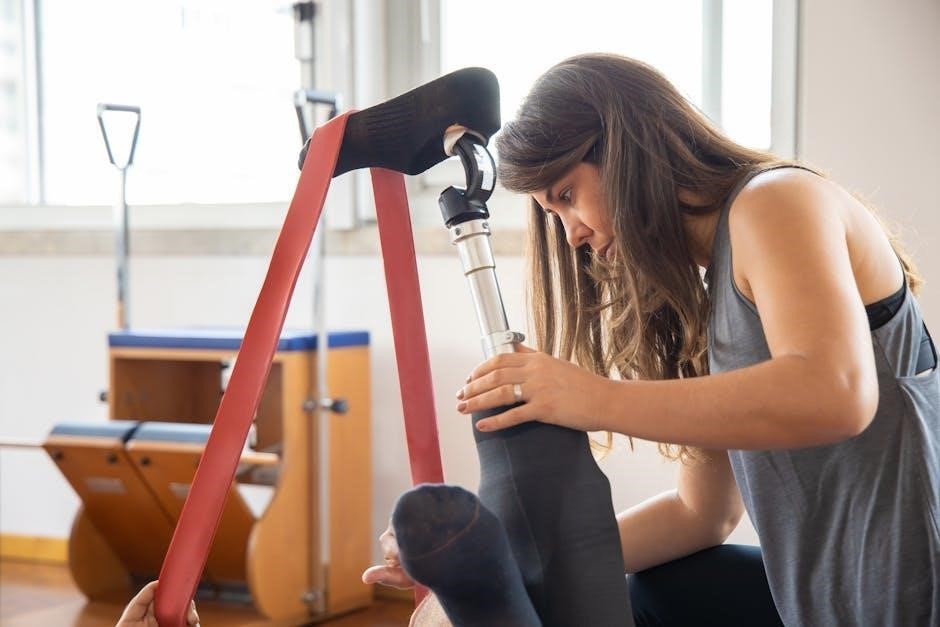Physical therapy evaluation templates are structured tools used to assess patients’ conditions, functional abilities, and treatment progress systematically. These templates ensure consistency and accuracy in documentation, aiding therapists in creating effective treatment plans and tracking patient outcomes efficiently.
1.1 What is a Physical Therapy Evaluation Template?
A physical therapy evaluation template is a structured document used by therapists to assess and document patient information, functional abilities, and treatment progress. It includes sections for patient history, current symptoms, and objective measurements, ensuring comprehensive and standardized assessments. These templates guide therapists in creating personalized treatment plans and monitoring outcomes effectively.
They often incorporate tools like the CERT checklist to enhance accuracy and consistency, making them indispensable in clinical practice for both initial evaluations and ongoing care.
1.2 Importance of Using Evaluation Templates in Physical Therapy
Using physical therapy evaluation templates ensures consistency, accuracy, and efficiency in patient assessments. These tools streamline documentation, saving time and reducing errors. They also ensure compliance with clinical standards and facilitate clear communication among healthcare providers. By standardizing assessments, templates enable therapists to focus on patient-specific needs, leading to more effective treatment plans and better outcomes. Regular use of these templates enhances the overall quality of care and improves patient monitoring throughout the therapy process.
Key Components of a Physical Therapy Evaluation Template
A physical therapy evaluation template typically includes patient history, current functional status, assessment of problems, and objective data measurements. These components ensure a comprehensive patient assessment.
2.1 Patient Information and History
Patient information and history sections in physical therapy evaluation templates capture essential details about the patient, including medical history, diagnosis, and current symptoms. This section helps therapists understand the patient’s background, identify potential factors influencing their condition, and develop a personalized treatment plan. Accurate documentation of patient history ensures continuity of care and informs clinical decision-making, making it a critical component of the evaluation process.
2.2 Current Functional Status and Abilities
The section on current functional status and abilities evaluates a patient’s existing physical capabilities, including mobility, strength, and daily task performance. This assessment helps identify limitations and baseline levels of function, guiding the development of realistic treatment goals. Therapists use standardized tools like the Functional Independence Measure (FIM) to document self-care and mobility skills, ensuring a comprehensive understanding of the patient’s current condition and potential for improvement through targeted interventions.
2.3 Assessment of Problems and Diagnosis
This section involves a detailed identification of the patient’s primary and secondary issues, linking symptoms to underlying conditions. It includes a diagnosis or working hypothesis based on clinical findings. Therapists use evidence-based practices to correlate patient history, symptoms, and test results, ensuring an accurate diagnosis. This step is crucial for developing targeted interventions and setting measurable goals, aligning treatment plans with the patient’s specific needs and promoting effective outcomes.
2.4 Objective Data and Measurements
Objective data and measurements are critical components of a physical therapy evaluation, providing quantifiable information about a patient’s condition. This includes range of motion, strength assessments, gait analysis, and functional tests. Tools like the CERT checklist ensure standardized reporting of exercise programs. These measurements help establish baseline levels, guide treatment planning, and monitor progress. Accurate documentation of objective data is essential for evidence-based practice and continuity of care, ensuring consistent and measurable patient outcomes.

The Role of the Consensus on Exercise Reporting Template (CERT)
CERT is a checklist promoting standardized reporting of exercise programs, ensuring consistency and reproducibility. It enhances documentation quality, aiding in evidence-based practice and research in physical therapy.
3.1 What is the CERT Checklist?
The CERT Checklist is a standardized tool designed to enhance the reporting of exercise interventions. It ensures detailed documentation of program components, including type, intensity, and duration, promoting consistency and reproducibility. By using CERT, physical therapists can improve the clarity and comparability of exercise data, facilitating better clinical decision-making and research.
3.2 How CERT is Integrated into Physical Therapy Evaluations
CERT is integrated into physical therapy evaluations by providing a structured format for documenting exercise programs. Therapists use it to detail program components, such as type, intensity, and duration. CERT ensures consistency in reporting, aiding in clinical decision-making and research. It is often included in initial assessments and progress tracking, standardizing how exercises are recorded and analyzed. This integration enhances reproducibility and clarity, making it easier to compare outcomes and refine treatment strategies.

Specialized Evaluation Forms for Specific Conditions
Specialized evaluation forms cater to specific conditions, such as elbow, wrist, or hand issues, ensuring targeted assessments. They also address neurosurgical patients with meningiomas, providing detailed insights.
4.1 Evaluation Forms for Elbow, Wrist, or Hand Issues
Evaluation forms for elbow, wrist, or hand issues are designed to assess range of motion, strength, and functional limitations. They include detailed sections for documenting patient history, current symptoms, and specific assessments like grip strength and joint mobility. These forms help physical therapists develop targeted treatment plans to improve dexterity and reduce pain in patients with upper limb conditions.
4.2 Forms for Neurosurgical Patients with Meningiomas
Evaluation forms for neurosurgical patients with meningiomas focus on post-surgery recovery and functional outcomes. They include assessments of cognitive and motor function, pain levels, and neurological deficits. These forms help track progress and guide rehabilitation strategies to improve quality of life. Specific sections address tumor-related symptoms and post-operative challenges, ensuring personalized care plans for patients undergoing neurosurgical interventions.
School-Based Physical Therapy Evaluation Forms
School-based physical therapy forms assess students’ abilities to participate in academic and physical activities. They focus on functional skills, mobility, and developmental needs to support educational goals.
5.1 Middle School and High School Physical Therapy Forms
Middle school and high school physical therapy forms are designed to assess students’ functional abilities in educational settings. These forms typically include sections for the student’s name, date of birth, OSIS number, and school details. They evaluate mobility, self-care, and participation in academic activities. The forms often incorporate standardized assessments, such as the Functional Independence Measure (FIM), to track progress. They are essential for developing individualized education programs (IEPs) and ensuring students receive appropriate support to meet their educational and developmental goals effectively;
5.2 Functional Assessment in Educational Settings
Functional assessments in educational settings focus on evaluating students’ abilities to perform daily tasks and participate in school activities. These assessments often utilize tools like the Functional Independence Measure (FIM), which measures self-care and mobility. The evaluations help identify barriers to learning and inform the development of tailored intervention strategies. By documenting a student’s functional capabilities, physical therapists can collaborate with educators to create supportive environments, ensuring students’ needs are met and fostering their academic success and overall well-being effectively.

Home Health Physical Therapy Evaluation Templates
Home health PT evaluation templates are designed to assess patients’ functional abilities and medical history in home settings, ensuring personalized care plans and accurate documentation of progress.
6.1 Contents of Home Health PT Evaluation Forms
Home health PT evaluation forms include patient demographics, medical history, current symptoms, functional status, and treatment goals. They also document physical assessments, such as strength, range of motion, and mobility, ensuring comprehensive care plans tailored to home environments. These forms are essential for tracking progress and adjusting therapies to meet individual patient needs effectively in home health settings.
6.2 Geriatric-Focused Evaluation Tools
Geriatric-focused evaluation tools are tailored to assess the unique needs of elderly patients, emphasizing functional abilities, mobility, and age-related conditions. These tools incorporate detailed assessments of strength, balance, and daily living activities, ensuring personalized care plans. They also address cognitive and physical challenges, providing a holistic view of the patient’s condition to support effective rehabilitation and improve quality of life for geriatric populations in home health settings.
Instructions for Completing Evaluation Forms
Licensed physical therapists must adhere to detailed guidelines when completing evaluation forms, ensuring accuracy in documenting patient histories, functional statuses, and assessment outcomes for effective treatment planning.
7.1 Guidelines for Licensed Physical Therapists
Licensed physical therapists must follow detailed guidelines when completing evaluation forms to ensure accuracy and comprehensiveness. They should thoroughly assess patient histories, current functional abilities, and problem diagnoses. Documentation must include objective measurements and standardized assessments, such as the Functional Independence Measure (FIM), to guide treatment planning. Therapists are required to use clear, concise language and adhere to professional standards. Referring to the form’s key for objective data tests ensures consistency and accuracy in interpretations. Compliance with these guidelines is essential for effective patient care and legal requirements.
7.2 Completing Objective Data Tests
Objective data tests in physical therapy evaluations require precise measurements and standardized methods to ensure reliability and reproducibility. Therapists must document range of motion, strength, and functional assessments accurately. Tests should be performed consistently, using validated tools and techniques to measure patient performance. Detailed records of these tests are essential for tracking progress and informing treatment decisions. Referencing the form’s key ensures proper interpretation and documentation of results, maintaining the integrity of the evaluation process and patient care outcomes.

Functional Assessment Tools
Functional assessment tools evaluate patients’ ability to perform daily activities and physical tasks, providing insights into their mobility, strength, and overall functional capabilities for treatment planning and progress tracking.
8.1 The Functional Independence Measure (FIM)
The Functional Independence Measure (FIM) is a widely used tool assessing patient independence in activities of daily living. It evaluates self-care, mobility, and communication, providing a standardized score to track progress. Used in clinical settings, the FIM helps therapists set realistic goals and monitor improvements in functional abilities, ensuring comprehensive care and effective rehabilitation outcomes for diverse patient populations.
8.2 Self-Care and Mobility Assessments
Self-care and mobility assessments evaluate a patient’s ability to perform daily activities and move independently. These evaluations focus on tasks like bathing, dressing, and walking, using standardized tools to measure functional capabilities. Mobility assessments include gait analysis, transfer techniques, and balance testing. By identifying strengths and limitations, therapists can design personalized treatment plans to enhance independence and improve quality of life, ensuring safe and effective rehabilitation outcomes for patients with varying physical challenges.

Comprehensive Guidelines for Physical Therapy Assessments
Self-care and mobility assessments evaluate a patient’s ability to perform daily activities and move independently. These evaluations use standardized tools to measure functional capabilities, focusing on tasks like bathing, dressing, and walking. Gait analysis, transfer techniques, and balance testing are common methods. By identifying strengths and limitations, therapists design personalized treatment plans to enhance independence and improve quality of life, ensuring safe and effective rehabilitation outcomes for patients with varying physical challenges.
9.1 Anatomy and Assessment Techniques
Anatomy and assessment techniques are foundational in physical therapy evaluations, focusing on understanding musculoskeletal and neurological systems. Therapists use methods like strength testing, range of motion measurements, and gait analysis to identify impairments. Palpation, joint mobility assessments, and special tests are also employed to evaluate specific conditions. These techniques ensure accurate diagnoses, guiding the development of targeted treatment plans. Proper anatomical knowledge and assessment skills are essential for effective patient care and rehabilitation outcomes.
9.2 Common Injuries and Disorders
Physical therapy evaluation templates often address common injuries and disorders, such as sprains, strains, and tendinopathies. Fractures, joint replacements, and degenerative conditions like arthritis are frequently assessed. Neurological disorders, including Parkinson’s and stroke-related impairments, are also evaluated. Templates help therapists document symptoms, functional limitations, and treatment goals for these conditions, ensuring targeted and effective care. Understanding these injuries and disorders is crucial for accurate assessments and personalized rehabilitation plans.

Downloadable PDF Resources for Physical Therapy Evaluations
Downloadable PDF resources offer comprehensive physical therapy evaluation templates, including sample forms and specialized tools for geriatric patients and specific conditions, ensuring efficient documentation.
10.1 Free Sample Evaluation Forms
Free sample evaluation forms are readily available in PDF format, providing therapists with customizable templates to document patient histories, functional statuses, and treatment plans. These forms are designed to streamline the evaluation process, ensuring thorough and standardized assessments while saving time. They often include sections for objective data, diagnoses, and progress tracking, making them invaluable tools for both clinical and educational settings. Therapists can easily adapt these templates to meet specific patient needs.
10.2 Tools for Specific Patient Groups (Females, Children)
Specialized evaluation tools cater to specific patient groups, such as females and children, ensuring tailored assessments that address unique needs. These templates include gender-specific health considerations and developmental milestones for pediatric patients. They also feature age-appropriate functional assessments, allowing therapists to track growth and progress effectively. These tools enhance personalized care, ensuring comprehensive and targeted interventions for diverse populations, making them essential resources for therapists working with specialized patient groups.
Physical Therapy Evaluation and Treatment Plan
A physical therapy evaluation guides the creation of a personalized treatment plan, focusing on improving mobility, strength, and reducing pain. It outlines clear goals, interventions, and progress monitoring strategies.
11.1 Structuring the Treatment Plan
Structuring a treatment plan involves defining clear, measurable goals based on evaluation findings. It outlines specific interventions, such as exercises, manual therapy, and modalities, tailored to the patient’s needs. The plan includes long-term and short-term objectives, ensuring a logical progression toward recovery. Progress is monitored through regular assessments, and adjustments are made as needed. Effective communication between the therapist and patient ensures alignment with goals, fostering a patient-centered approach. Documentation and compliance with clinical standards are essential for accountability and optimal outcomes.
11.2 Tracking Progress and Outcomes
Tracking progress and outcomes involves systematically documenting improvements in patients’ functional abilities and symptom reduction. Regular assessments using tools like the Functional Independence Measure (FIM) help quantify advancements. Objective data, such as range of motion and strength measurements, are compared to baseline values to demonstrate progress. This documentation not only ensures accountability but also aids in adjusting treatment plans to meet evolving patient needs, ultimately enhancing the effectiveness of care and patient engagement in their recovery journey.
Patient-Specific Evaluation Forms
Patient-specific evaluation forms are customized to address individual needs, ensuring personalized care. They include detailed assessments for unique conditions, such as pro bono clinic evaluations or geriatric-focused tools, tailored to specific patient populations for accurate documentation and effective treatment planning.
12.1 Forms for Pro Bono Clinics
Pro bono clinic evaluation forms are designed for patients receiving free or reduced-cost physical therapy services. These forms often include detailed assessment sections tailored to specific conditions, such as elbow, wrist, or hand issues. They are used by physical therapy students and licensed therapists to document patient history, functional status, and treatment plans. The forms ensure comprehensive care for underserved populations, focusing on improving mobility and quality of life through structured evaluations and interventions.
12.2 Customized Templates for Geriatric Patients
Customized templates for geriatric patients focus on age-related conditions, mobility challenges, and chronic diseases. These forms include sections for assessing balance, flexibility, and functional abilities tailored to elderly needs. They often integrate tools like the Functional Independence Measure (FIM) to evaluate self-care and mobility. Geriatric templates ensure comprehensive care plans, addressing specific health concerns such as arthritis or frailty, while adhering to legal and professional documentation standards for elderly patient assessments and treatment monitoring.

Legal and Professional Requirements
Physical therapy evaluations must comply with legal standards, ensuring patient confidentiality and informed consent. Accurate documentation and adherence to professional guidelines are essential to prevent legal issues and maintain trust.
13.1 Compliance with Clinical Standards
Compliance with clinical standards ensures physical therapy evaluations meet established guidelines, promoting accurate documentation and legal adherence. Standardized templates help therapists collect patient data consistently, covering history, functional status, and assessments. These tools ensure evaluations align with professional norms, enabling reliable tracking of progress and outcomes. Adherence to standards like the CERT checklist and functional assessments (e.g., FIM) guarantees comprehensive and ethical patient care, maintaining trust and professionalism in therapy practices.
13.2 Documentation Best Practices
Accurate and thorough documentation is crucial in physical therapy evaluations. Best practices include using standardized templates to ensure consistency and clarity. Timely completion of evaluation forms, with clear and objective data, enhances patient care continuity. Therapists should use professional terminology and avoid ambiguity. Regular updates and adherence to confidentiality protocols are essential. Proper documentation also aids in legal compliance and facilitates effective communication among healthcare providers, ensuring comprehensive and patient-centered care throughout the treatment process.
Digital Integration of Evaluation Templates
Digital integration of evaluation templates enhances efficiency and accuracy in physical therapy practices. PDF templates are widely used for their accessibility and usability across devices. Clinicians can easily fill, save, and share these forms electronically, reducing paperwork. Digital tools also support integration with electronic health records (EHR) systems, streamlining patient data management. Future trends include AI-driven templates and cloud-based solutions, enabling real-time collaboration and secure patient information handling, ultimately improving documentation and care delivery workflows.
14.1 PDF Accessibility and Usability
PDF templates for physical therapy evaluations are highly accessible and user-friendly. They can be easily downloaded, completed, and shared across devices. Many PDFs are form-fillable, allowing therapists to input patient data efficiently. These templates are compatible with various operating systems and devices, ensuring widespread usability. Additionally, PDFs support accessibility features, such as screen reader compatibility, making them inclusive for users with disabilities. Their ability to maintain formatting and security ensures consistent and professional documentation, benefiting both clinicians and patients.
14.2 Future Trends in Digital Documentation
The future of digital documentation in physical therapy is poised to integrate advanced technologies like AI and machine learning to enhance accuracy and efficiency. Cloud-based platforms will enable seamless data sharing and real-time collaboration among healthcare providers. Automated data entry and predictive analytics will streamline patient assessments, while interactive templates will adapt to individual patient needs. These innovations aim to improve accessibility, reduce administrative burdens, and enhance patient care outcomes, ensuring documentation remains patient-centric and efficient.
Physical therapy evaluation templates streamline documentation, ensuring consistency and accuracy in patient assessments. They enhance therapy practices by providing structured frameworks for tracking progress and improving outcomes effectively.
15.1 Summary of Key Points
Physical therapy evaluation templates provide a structured approach to patient assessments, ensuring consistency and accuracy in documentation. They cover essential aspects such as patient history, functional status, and objective measurements. Tools like the CERT checklist enhance evaluation accuracy, while specialized forms address specific conditions, such as elbow injuries or neurosurgical cases. These templates also support school-based and home health settings, offering tailored tools for geriatric and pediatric patients. Their digital integration and accessibility further improve efficiency, making them indispensable in modern therapy practices.
15.2 Final Thoughts on the Importance of Evaluation Templates
Physical therapy evaluation templates are indispensable tools for ensuring comprehensive, accurate, and consistent patient assessments. They streamline documentation, enhance clinical decision-making, and improve patient care outcomes. By standardizing evaluations, these templates enable therapists to track progress effectively and communicate clearly with other healthcare professionals. Their adaptability to various settings, such as schools, home health, and specialized clinics, underscores their versatility and value in modern physical therapy practice.
